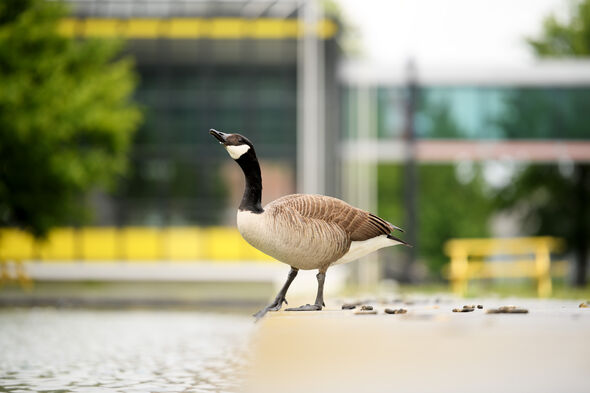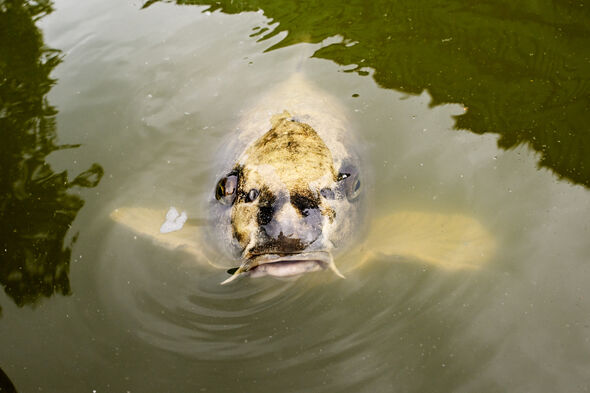
TU/e fish Egbert may be moving
Can the carp actually survive in what looks like a dirty pond?
Many people at TU/e know Egbert, the friendly, chubby carp in the pond outside Atlas. TU/e staff member Marjolijn van den Heuvel noticed that the pond looks quite dirty and that Egbert seems to be living a life of celibacy. That’s why she reached out to TU/e and had a carp advisor come by to see what’s best for Egbert’s future. Will he stay put or be moved to a different location?
“First and foremost, Egbert is healthy,” says Marco Zegers of the koi carp and pond advice group. “This may come as a surprise, but the pond isn’t as dirty as it looks. Measurements of the water revealed that the amounts of nitrate and nitrite weren’t too bad at all. It was just the amount of ammonia that was too high.” Van den Heuvel: “This can easily be explained by all of the feces the geese leave behind, which regularly get hosed into the pond during cleaning sessions. But TU/e promised me that that won’t happen again, in an effort to keep Egbert’s living area cleaner.”
Van den Heuvel works with figures every day, as she’s in the reporting and analysis team at Finance & Control. But she’s also very fond of animals and felt the need to have Egbert’s health properly reviewed. “About two months ago, I was walking outside with a colleague and saw the dirty pond. Suddenly, a fish appeared. This surprised me and I found myself thinking it didn’t look like a healthy situation for the animal.”
“A friend of mine works at Glorieux, an estate where they also have a pond with carp, so I thought that may be a better option. But the fish would only be welcome there if it’s healthy, so I decided to find a carp advisor.” She also contacted Thijs Mooren, management and maintenance account manager at TU/e, upon which she found out the fish is called Egbert and even has its own Instagram account (@egbertthefish), which she reached out to as well.
Medical examination
Egbert’s medical examination confirmed that he’s male, and that he looks healthy and fine. Van den Heuvel also learned a lot from listening to the carp advisor. “He can tell by the position of the gills (so the way they move during breathing, ed.) whether the fish is in fight or flight mode. And Egbert’s gills show he’s relaxed and happy.”
Egbert isn’t a wild carp, but a mukashi ogon carp. “Mukashi means antique gold in Japanese, and ogon means metallic. It describes Egbert’s color. It’s a type of carp that’s easy to tame,” says Zegers. “But the koi karp is a group animal by nature, so it would be better to find a girlfriend for Egbert. The pond he’s in is deep enough, in any case. The water depth is 1 meter and that’s sufficient to shelter from the heat in summer and from the cold in winter.”
Although the pond looks dirty, the water quality isn’t all that bad. “There are algae in there that provide an organic food source,” says Zegers. “But the goose feces, on the other hand, are harmful.” Mooren: “Now we know this, we won’t hose them into the pond anymore.”
Van den Heuvel: “Fortunately, the inspection of the pond revealed that the situation isn’t too bad and that there’s a good oxygen mechanism in the pond, which helps keep the living climate stable when there are major temperature differences.”
Zegers wasn’t able to perform the entire medical examination of the fish as it proved difficult to catch. He lured him with a breadstick, which Egbert eagerly approached, but when Zegers tried to scrape a small sample off Egbert’s mucous membrane, the fish instantly swam off. It was therefore not possible to ascertain whether he’s carrying too many parasites. Zegers: “Every carp has some of those, but if there are too many, it can be dangerous. But I don’t expect that to be the case here, as the fish looks really healthy overall.”
Food
It happens regularly that bread is thrown into the pond for Egbert, but is that actually good for him? Zegers: “In principle, carp don’t need to be fed, because the balance of the pond has to be such that it provides enough food. A pond generally provides enough food for the fish that live in it, providing it has plants and whatnot.” Which isn’t the case with the Atlas pond. Does that mean Egbert’s hungry?
Zegers: “It doesn’t look like it, because the pond does have algae, which really are Egbert’s friends, as they excrete a substance on which he feeds. It won’t hurt to give him a bit of bread, but don’t throw any in there with sweet fillings, like hagelslag or chocolate spread. This will make his insulin skyrocket. And in any case, don’t provide too much extra food. If a fish is offered too much food, it will not be eaten and start to rot. And that can make the animal sick later on.”
A new partner
Zegers agrees Egbert could use a friend, even though he’s currently not living completely on his own. Van den Heuvel was surprised by the fact that there are also minnows living in the pond. But another carp would be better company for Egbert than the small minnows. Zegers does think Egbert would be better of with having another male as a companion than a female. “Males don’t lay eggs, which affect the ammonia value of the water. So a male would be a bit better. Having said that, Egbert would be able to live together with a companion of either sex.”
Response from the pond
Cursor also spoke with both the fish and its spokesperson, who wishes to stay anonymous. “Blub, blub, blub, I would definitely like some company. I’m fine with a guy friend, although I’d also be up for making babies. That would be the end of my cult status, so I’m actually a bit on the fence about it, blubbie, blub. I’d really love it if my new friend were a different carp species than myself, like the carp advisor already suggested. Then at least you would still be able to recognize me. Egbert, THE fish.
Blub blub blub.”
Egbert’s spokesperson says he channels the fish. This means that people who contact him on Instagram generally only get ‘blubblub’ in return. In highly exceptional cases, Egbert might comment more elaborately or share a quirky video or opinion. You can follow him at @egbertthefish
“Carp are pretty expensive,” says Van den Heuvel. “But if the community really is that fond of Egbert, I thought we could start a crowdfunding campaign to buy a partner for him. Fish usually live in schools, so it’s natural for them to have a partner of the same species in any case.” Van den Heuvel also has a name in mind for his future girlfriend: Carper Diem. “I was actually planning on calling Egbert that, until I found out he already has a name.”
Zegers has a few tips for types of carp that would be suitable to live with Egbert: chagoi, soragoi, or karashigoi. Those are easy to tame and grow quite big, ensuring they’re not an easy prey for herons.
Move
Mooren says TU/e is open to moving Egbert to the Blauwe Loper if this is better for his health. But it’s not that easy to move a carp this size. Zegers: “Catching the animal with a fishing rod would cause it unnecessary stress. A normal net is too small, so I think a dragnet would be the best option. Which means it’d be best to call in a professional fisher.” Egbert’s spokesperson (the one from the @egbertthefish Instagram account) indicated he would like to be present in case Egbert is moved and even offered to move the fish himself. He’s convinced this would be easy because Egbert is so eager to approach people, particularly him.
But it’s by no means sure that Egbert will move. There’s nothing that’s stopping him from growing old in the pond at Atlas, Zegers says. Mooren is happy to hear that, but he can also imagine Egbert would be better off in the Blauwe Loper. “Everything looks a bit more natural there. As more of an architectonic and cultural-historical element of the campus, the pond at Atlas isn’t geared towards housing fish. In the Blauwe Loper, Egbert would have more room and it has a layer of clay going around it in which plants can grow. We’re going to sow those, but it will take about a year for that vegetation to arrive.” The introduction of a partner is also no certainty yet. “In the 250-meter long Blauwe Loper it would definitely be a bit easier to put in one partner.”
History
How did the fish get into the Atlas pond in the first place? Mooren doesn’t know: “One day, there was a fish in the pond at Atlas.” Van Den Heuvel: “My mother used to work at the Paviljoen on campus and remembers a colleague who would go pet carp at the pond outside the building. Maybe Egbert came from that pond?” Unfortunately, it turns out that former colleague already retired and cannot be tracked down. But we were able to find a facility officer who confirms the carp from the former Paviljoen pond were moved to different ponds to prevent them from being bothered by the renovation of the Paviljoen and the overhaul of the pond itself. So Egbert is one of those fish.
Egbert is the only one to have moved to the Atlas pond; the other carp are in the pond next to De Zwarte Doos, the facility officer tells us. If Egbert were to move to the Blauwe Loper, he would be very close to his old home once again.
Finally, a word of caution to those reading this and thinking ‘I actually have a fish at home that I can’t take care of anymore or that wants to move to a bigger home. Why don’t I put it with Egbert?’ Zegers warns that it’s not a good idea to set a ‘house fish’ free in nature just like that. “You don’t know how healthy your fish is and how it could possibly disrupt the new environment that it’s released into. That’s why we first perform a medical examination. This is in the interest of the fish itself and that of the other fish in the new pond.”





Discussion